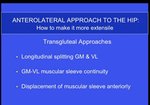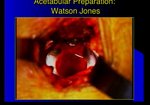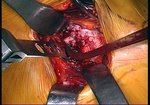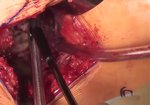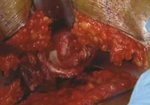Playback speed
10 seconds
Anterolateral MIS Approach for Hip Arthroplasty: New Modified Surgical Technique
7,420 views
February 12, 2021
Nikolaos Christodoulou, Orthopedic Surgeon MD, PhD
Chairman of Orthopedic Department, Athens Medical Group / Iatriko ...
read more ↘ Psychikou Athens - Greece
www.christodoulou-n.gr
This modified anterolateral MIS approach is proposed as an alternative technique in order to avoid severe abductors and superior gluteal nerve injury that may occur in classic lateral approaches with the leg in figure four position, as well as to avoid the short external rotators release which is necessary in posterior approaches and sometimes in anterior MIS approaches, for example the piriformis release from inside, not repairable, in order to mobilize the femur and avoid femoral fractures.
This release may sometimes lead to hip laxity, necessity of longer arthroplasty neck, offset stem or augmented cup anteversion resulting to leg lengthening, trochanteritis or posterior impingement syndrome respectively.
This approach is easy because it is adapted to the direction of normal functional anatomy and kinesiology of the hip joint so we have excellent view for both, acetabulum and femur.
Usually, there are not facing problems from vessels or nerves.
The superior gluteal nerve branches are relaxed during surgery in contrast to lateral classic transgluteal approaches and there is not any danger of lateral femoral cutaneous nerve. No injuries of vastus lateralis or lateral circumflex artery so the blood loss is minimal.
The main gluteus medius insertion to the greater trochanter, important for hip abduction, remains intact.
The only minimal and repairable injury is the temporary elevation of gluteus minimus insertional tendon and few anterior oblique fibers of gluteus medius re-sutured strongly at their normal place at the end of surgery.
Gluteus minimus injury has minor impact in clinical outcomes.
This technique does not require any leg traction, nor expensive or multipolar surgical table. This approach is also easily extensible for difficult or revision cases.
References:
ALMIS Anterolateral Hip Approach Using a Different Table and Legs Position during Femoral Exposure; New Surgical Technique. Nikolaos Christodoulou. MOJ Orthopedics & Reumatology, Volume 7, Issue 4, 2017 (USA)
http://medcraveonline.com/MOJOR/MOJOR-07-00282.pdf.
New Generation Titanium Biologically Fixed Threaded Implants in Jawbone and Hip Joint (Editorial). Nikolaos Christodoulou. MOJ Orthop Rheumatol 9(5): 00371, 2017 (U.S.A.)
http://medcraveonline.com/MOJOR/MOJOR-09-00371.pdf
↖ read less
Chairman of Orthopedic Department, Athens Medical Group / Iatriko ...
read more ↘ Psychikou Athens - Greece
www.christodoulou-n.gr
This modified anterolateral MIS approach is proposed as an alternative technique in order to avoid severe abductors and superior gluteal nerve injury that may occur in classic lateral approaches with the leg in figure four position, as well as to avoid the short external rotators release which is necessary in posterior approaches and sometimes in anterior MIS approaches, for example the piriformis release from inside, not repairable, in order to mobilize the femur and avoid femoral fractures.
This release may sometimes lead to hip laxity, necessity of longer arthroplasty neck, offset stem or augmented cup anteversion resulting to leg lengthening, trochanteritis or posterior impingement syndrome respectively.
This approach is easy because it is adapted to the direction of normal functional anatomy and kinesiology of the hip joint so we have excellent view for both, acetabulum and femur.
Usually, there are not facing problems from vessels or nerves.
The superior gluteal nerve branches are relaxed during surgery in contrast to lateral classic transgluteal approaches and there is not any danger of lateral femoral cutaneous nerve. No injuries of vastus lateralis or lateral circumflex artery so the blood loss is minimal.
The main gluteus medius insertion to the greater trochanter, important for hip abduction, remains intact.
The only minimal and repairable injury is the temporary elevation of gluteus minimus insertional tendon and few anterior oblique fibers of gluteus medius re-sutured strongly at their normal place at the end of surgery.
Gluteus minimus injury has minor impact in clinical outcomes.
This technique does not require any leg traction, nor expensive or multipolar surgical table. This approach is also easily extensible for difficult or revision cases.
References:
ALMIS Anterolateral Hip Approach Using a Different Table and Legs Position during Femoral Exposure; New Surgical Technique. Nikolaos Christodoulou. MOJ Orthopedics & Reumatology, Volume 7, Issue 4, 2017 (USA)
http://medcraveonline.com/MOJOR/MOJOR-07-00282.pdf.
New Generation Titanium Biologically Fixed Threaded Implants in Jawbone and Hip Joint (Editorial). Nikolaos Christodoulou. MOJ Orthop Rheumatol 9(5): 00371, 2017 (U.S.A.)
http://medcraveonline.com/MOJOR/MOJOR-09-00371.pdf
↖ read less
Comments 4
Login to view comments.
Click here to Login
